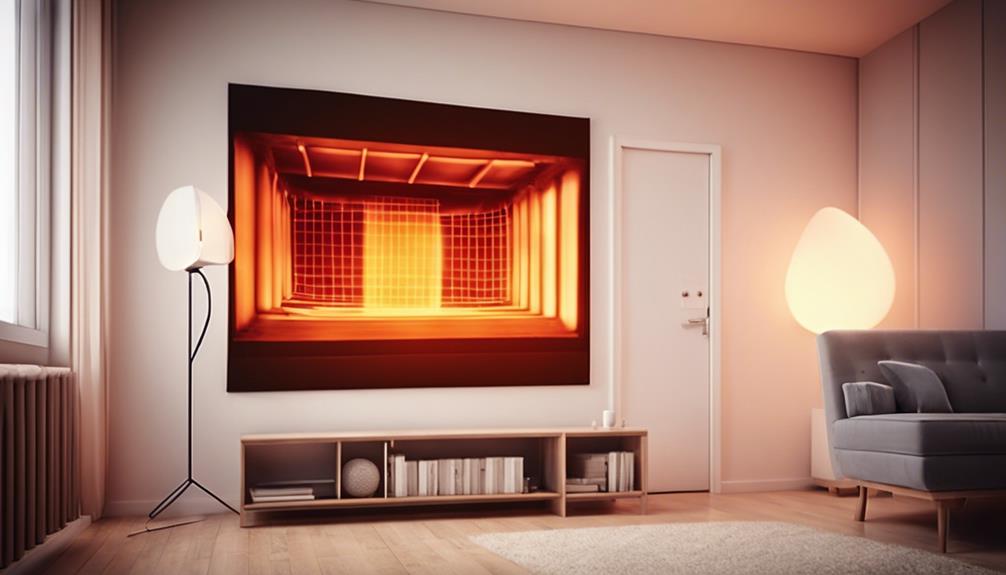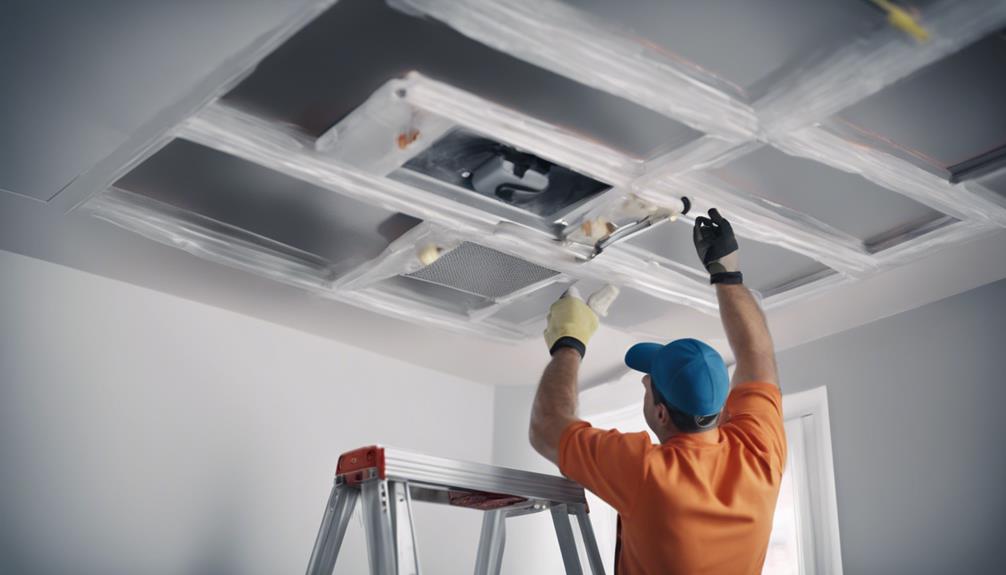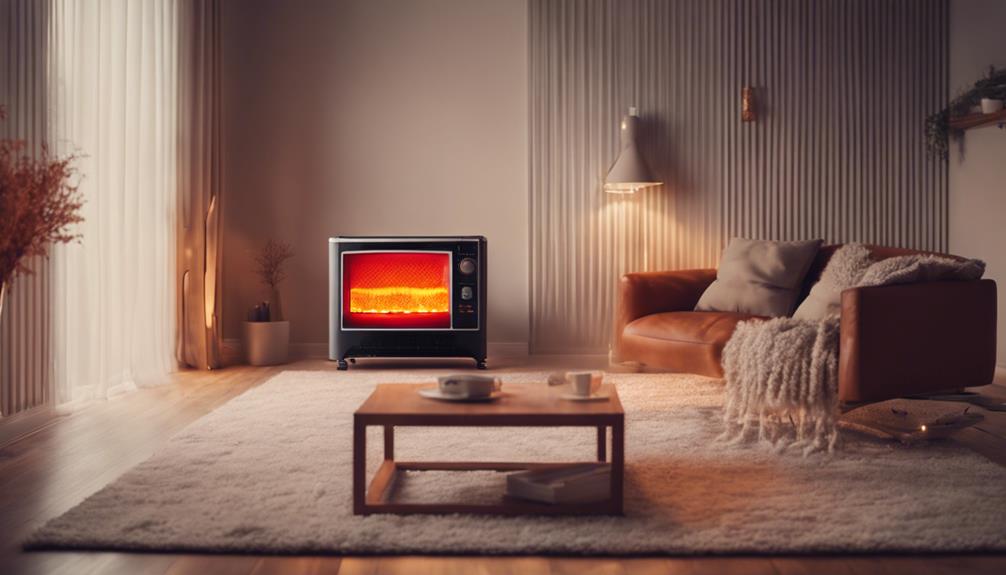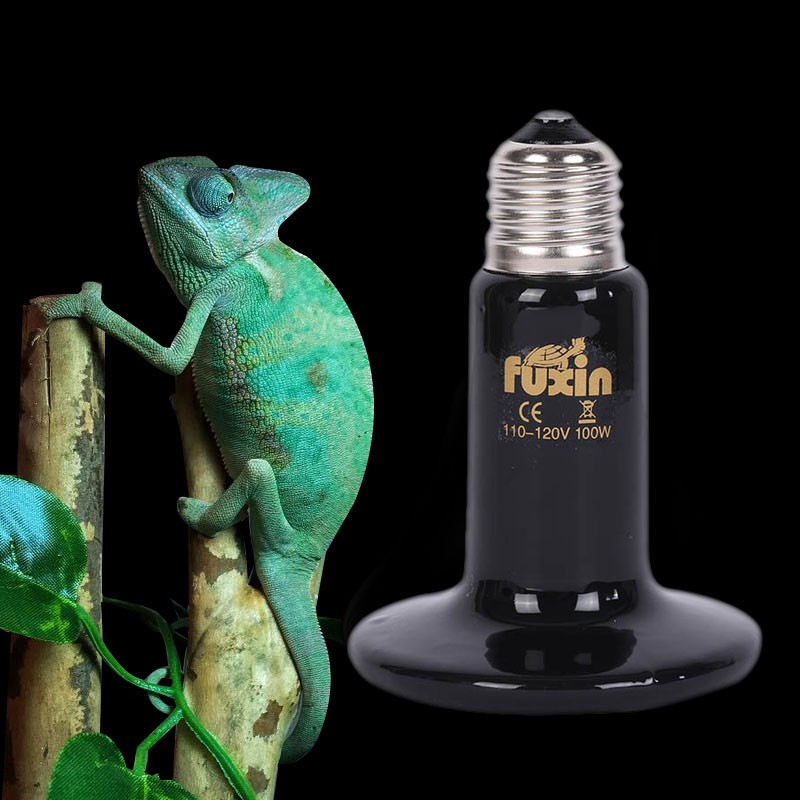
Maximize your energy efficiency with infrared heaters, the innovative solution for quick and targeted warmth without the need to preheat the room. These heaters operate by directly heating objects and people, avoiding the circulation of dust or allergens and maintaining better air quality. By focusing on energy-efficient practices like using programmable thermostats and zoning your heating system, you can optimize your energy savings while enjoying the benefits of improved blood circulation and reduced muscle/joint pain. Discover how infrared heaters can greatly impact your comfort and costs with real-world case studies showcasing impressive energy reductions and increased savings.
Understanding Infrared Heater Technology

If you've ever wondered how infrared heaters work, you're in the right place. Infrared heaters operate on the principles of heat transfer mechanisms. Unlike traditional heaters that warm the air, infrared heaters emit infrared radiation that directly heats objects and people in its path. This process is similar to how the sun warms the Earth.
The key to understanding infrared heater technology lies in comprehending the difference between convection heating and radiant heating. Convection heaters warm the air, which then heats the room. In contrast, infrared heaters emit infrared radiation that heats objects and individuals without needing to warm the air first.
This method isn't only more energy-efficient but also provides instant warmth.
Benefits of Infrared Heaters
Discover the numerous advantages of using infrared heaters in your home or workspace. Infrared heaters provide not only warmth but also health benefits. Unlike traditional heaters that can circulate dust and allergens in the air, infrared heaters operate without drying out the air or causing respiratory issues.
The gentle infrared heat can even improve blood circulation and alleviate muscle and joint pain, making them a great choice for individuals with arthritis or other conditions that benefit from targeted heat therapy.
Moreover, the environmental impact of infrared heaters is favorable. These heaters are energy-efficient, converting nearly all the electricity they consume into radiant heat. This efficiency not only helps reduce energy consumption but also lowers carbon emissions, making them a more eco-friendly heating option.
Comparing Energy Efficiency

When comparing energy efficiency, it's important to contemplate how infrared heaters stand out regarding their ability to convert electricity into radiant heat effectively. Infrared heaters are known for their high infrared efficiency, meaning they can directly heat objects and individuals without heating the surrounding air first. This targeted heating approach reduces energy wastage commonly seen in traditional convection heaters where heated air quickly rises to the ceiling.
Compared to conventional heaters, infrared heaters provide instant warmth as soon as they're turned on, eliminating the need to preheat a room. Additionally, the focused heat distribution of infrared heaters allows for quicker and more efficient heating, leading to potential energy savings in the long run.
When conducting a heater comparison based on energy efficiency, considering the infrared efficiency of infrared heaters can play a significant role in optimizing energy consumption. By harnessing the power of radiant heat, these heaters offer a practical solution for maximizing warmth while minimizing energy usage.
Cost Savings Analysis
To assess the cost savings potential of using infrared heaters, analyze your current energy consumption patterns and compare them to the efficiency of infrared heating technology.
Start by calculating your current energy costs for heating using your existing system.
Then, research the energy consumption rates of infrared heaters to estimate potential savings.
Consider factors like the size of the area you need to heat, insulation levels, and local energy prices for an extensive cost comparison.
Installation and Maintenance Tips

Consider these practical installation and maintenance tips to guarantee peak performance and longevity of your infrared heater.
When installing your infrared heater, make certain it's mounted according to the manufacturer's installation guidelines. Position the heater at the recommended height and angle for ideal heat distribution.
Regular maintenance is key to maximizing efficiency. Clean the heater periodically to remove dust and debris that can obstruct heat emission. Check for any signs of wear and tear on the heating elements and promptly replace any damaged parts. Inspect the wiring for any loose connections or fraying that may affect the heater's performance.
Additionally, make sure to schedule professional maintenance at least once a year to keep your infrared heater in top condition.
Best Practices for Energy Optimization
For ideal energy efficiency with your infrared heater, implement these recommended best practices to maximize performance and minimize energy consumption.
To enhance energy management, make certain your heater is installed in a location where it can evenly distribute heat throughout the space. Proper installation height and angle are essential for achieving the best thermal comfort without wasting energy. Regular maintenance, such as cleaning the heating elements and verifying proper insulation, can greatly improve energy efficiency.
Utilize programmable thermostats to manage the heater's operation based on occupancy schedules, avoiding unnecessary energy consumption when the space is unoccupied. Additionally, consider zoning the heating system to only heat occupied areas, further reducing energy waste. Proper sealing of windows, doors, and any potential drafts will help maintain thermal comfort levels without overworking the heater.
Monitoring energy usage and adjusting settings accordingly can also contribute to energy enhancement. By following these best practices, you can maximize energy efficiency, reduce energy costs, and create a comfortable environment for occupants.
Case Studies: Real Energy Savings

Explore real-world examples of energy savings achieved through the implementation of infrared heaters in various settings.
In a recent case study at a commercial warehouse, switching to infrared heaters resulted in a 30% reduction in energy consumption compared to traditional heating systems. By targeting specific areas where heat was needed most, the warehouse could optimize energy usage efficiently.
Another example comes from a restaurant chain that installed infrared heaters in their outdoor dining spaces. This move not only increased customer comfort but also led to a 25% decrease in energy consumption during the colder months. The focused heat provided by the infrared heaters allowed the restaurant to save on overall heating costs while creating a cozy atmosphere for patrons.
These real-world examples demonstrate the significant impact that infrared heaters can have on energy savings in diverse environments.
Conclusion
To summarize, by utilizing infrared heaters, you can optimize energy savings in your space.
With their efficient technology and cost-effective operation, infrared heaters offer a practical solution for reducing energy consumption and lowering utility costs.
By following installation and maintenance tips, as well as implementing best practices for energy optimization, you can achieve real energy savings and create a more sustainable environment.
Make the switch to infrared heaters today and start reaping the benefits of increased energy efficiency.

